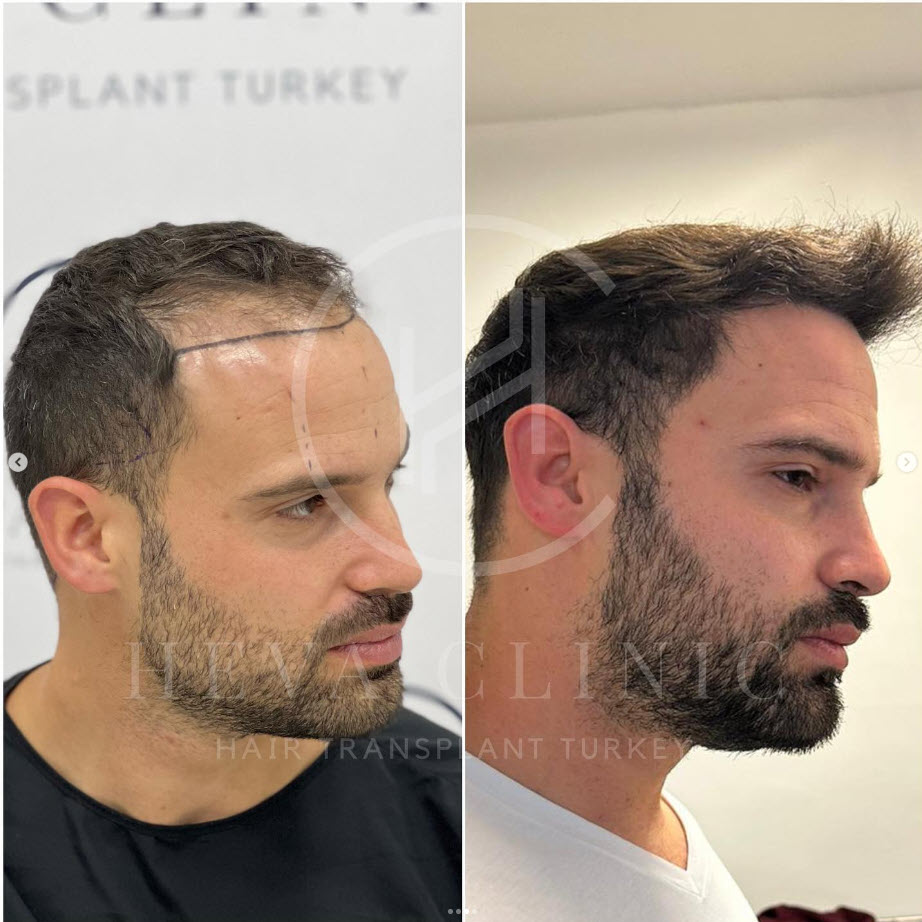
The M or V-shaped spot on the hairline in the middle of the frontal part of the head is called the Widow’s Peak. Hair growth on the upper part of the face is suppressed within paired regions surrounding the central forehead area. A widows peak may appear if the upper parts of these pairs on the forehead are lower than expected. [1]
Today’s research demonstrates that it is not related to gender; both women and men can have a widows peak equally. (It occurs in around 30% of women and 32% of men.) [2]
A technique that addresses the correction of such areas is called a widow’s peak hair transplant, and it generally makes one look a decade younger.
Can a Hair Transplant Fix a Widow’s Peak?
Yes, the only way to permanently treat widow’s peak is hair transplantation. In this procedure, active hair follicles from the donor area are placed in the recipient area, the temples. This allows the dense and thick hair tissue from the back of your ears starts to grow on your temples.
Can I Get a Hair Transplant for Widow’s Peak?
You can undergo a widow’s peak hair transplant if you meet the criteria below:
The most important factors here are hair density and the size of the donor area. If you have a sufficient amount of healthy existing hair, and your overall health condition is suitable for surgery, you can undergo a widows peak treatment.
How Does a Widows Peak Hair Transplant Work?
The most modern technique for widows peak hair transplant is the FUE & DHI method.
However, the FUE procedure has sub-branches. These are

Your surgeon decides which technique to treat widows peak type hair loss.
The following factors play a role in your surgeon’s decision:

What are the steps of Widow’s Peak Hair Transplant?
First, you will meet with the surgeon to discuss your medical background, concerns, and expectations. This initial consultation ensures that the surgeon understands your needs and can plan the procedure accordingly.
On the day of the surgery, the surgeon will prepare your donor site by applying local anesthesia and, if necessary, shaving the area. Local anesthesia minimizes discomfort while keeping you conscious. The surgeon will then perform hair extraction, carefully removing the grafts from the donor site.
Next, the surgeon will create microchannels in the recipient area to prepare for implantation. The extracted grafts will be transplanted into these channels.
After the surgery is complete, you will receive instructions on cleaning, medication, and post-operation management to ensure proper healing and optimal results.
How Many Grafts Does It Take to Fix a Widow’s Peak?
In general, around 500 to 1500 grafts are enough to achieve a dense look at the temples. However, some patients may require more than 2000 grafts to achieve the desired appearance.
If you would like to share your photos with us, we can determine how many grafts you may need.
How Long Does the Procedure Take?
Due to the relatively small size of the recipient area, the procedure takes between 3 to 7 hours to complete.
Depending on the patient, the size of the area, the number of hair follicles, and the difficulty of the surgery according to the type of hair (curly, wavy, straight) varies.
The procedure is completed within a day and then you can rest at home.
Around 2 weeks, you can turn back to your daily activities.

What Is the Best Hair Treatment for Widow’s Peak?
Even though discussing with your hairdresser on how to pick a hairstyle for widows peaks that effectively conceal the appearance is one of the solutions, it’s not a permanent solution.
The hair transplant is the best treatment for widow’s peak hair loss. This surgical procedure involves transferring hair follicles from a donor area to the widow’s peak area to achieve a more dense appearance.
Why is Hair Transplant the Best Treatment for Widow’s Peak?

1. Natural Appearance
Widows peak hair transplant is the only solution that directly improves facial symmetry by restoring the V-shaped hairline characteristic of it. So you get more natural look, permanently.

2. State-of-the-Art Medical Approach
A hair transplant minimally invasively transfers healthy hair follicles from the rich area to the thin part. Compared to alternatives, this medical technique’s very high success rate, 98% in someone with widows-peaks hair loss signals at stage 1 to 2 levels on the Norwood Scale..

3. Customizability
The surgeon can customize the operation to suit the individual’s facial features, expectations and needs. Newly transplanted hair seems in harmony with the existing hair.

4. Easy Recovery Process
Hair transplant has a quick recovery period unlike alternative hair loss treatments. Within a few days to a week, you can return to your daily activities.
Can Minoxidil Fix Widow’s Peak?
Many high-potency minoxidil products are effective for increasing hair density. They help hair regrowth in stubborn areas. It is used in the treatment of many types of baldness, especially androgenic alopecia. However, the effects disappear within a few months after stopping the treatment. That’s why they are not enough for a permanent solution.
Can Finasteride Regrow Widow’s Peak?
As an FDA-approved medication, it is used to treat hair loss and focuses directly on male androgenetic alopecia, i.e. receding hairlines. While it can slow hair loss and in some cases even promote hair regrowth, it is important to note that its effectiveness varies depending on individual conditions.
Research has shown that it can visibly increase hair count and improve hair growth in patients with frontal hair loss. However, some are able to experience noticeable improvements, while others may not see noticeable regrowth.
Therefore, while finasteride can be a valuable tool in combating hair loss, it’s not a solution for everyone. Individual responses to the medication can vary, and factors such as genetics, the severity of hair loss, and adherence to treatment play significant roles in determining its effectiveness. [3] [4] [5]

How Long Is the Recovery Period After Widows Peak Hair Transplant?
Here is a short summary of the recovery process:
Which Celebrities Have Widow’s Peak Hair?
Many celebrities in Hollywood have a widow’s peak. These celebrities, who have a hair cluster at the center above their foreheads, exhibit a V or M-shaped appearance as their hairlines recede.

Here are some of those celebrities with widow’s peak: Josh Duhamel, Kate Walsh, Leonardo DiCaprio, Milla Jovovich, Alyson Hannigan, David Beckham, Keanu Reeves, Denis Leary, Nicole Kidman, Kourtney Kardashian, Marilyn Monroe, Denis Leary, Adrian Grenier
How to Choose Your Clinic to Fix Widow’s Peak?
When choosing the best clinic for hair transplantation, you should pay attention to these things:
1. Research
Look for clinics that specialize in hair restoration, have a successful team and positive reviews.
2. Expertise
Make sure the clinic has experienced surgeons skilled in widow peak restoration. You can get an idea by looking at the clinic’s widow’s peak hair transplant before after photos.
3. Technology
Please, prefer clinics that use advanced techniques such as FUE for optimal results. For example, you can examine whether they adapt to the newest technological advances such as NeoGraft or Robotic FUE.
4. Consultation
Schedule consultations to discuss your concerns and evaluate the clinic’s approach. You can also choose a clinic with a hair transplant blog and read about their procedures there.
5. Results
Review before & after hair transplant photos to gauge the clinic’s success in treating widow’s peak.
At Heva Clinic, we strive to deliver excellence in widow’s peak treatment with our advanced techniques and experienced team of surgeons. Our Istanbul-based clinic is full of young and talented medical team and state-of-the-art equipment. With a focus on personalized care and exceptional results, we strive to meet your expectations and see you off with 100% satisfaction.
References:
- 1.Widows peak. Biology Articles, Tutorials & Dictionary Online. Published October 7, 2019. Accessed April 5, 2024. https://www.biologyonline.com/dictionary/widows-peak
- Anibor, Ese, et al. “The distribution of widow’s peak trait among young adults of the Isoko ethnic group in Delta State, Nigeria.” Annals of Bioanthropology, vol. 3, no. 2, July-Dec. 2015, p. 47. Gale Academic OneFile, link.gale.com/apps/doc/A441456126/AONE?u=anon~edcfbb84&sid=googleScholar&xid=0e15d819 Accessed 5 Apr. 2024.
- Kaufman KD, Olsen EA, Whiting D, et al. Finasteride in the treatment of men with androgenetic alopecia. J Am Acad Dermatol. 1998;39(4 Pt 1):578-589. doi:10.1016/s0190-9622(98)70007-6
- Lee S, Choi M, Choi Y, et al. Efficacy and safety of 3% minoxidil versus combined 3% minoxidil / 0.1% finasteride in male pattern hair loss: a randomized, double-blind, comparative study. Am J Clin Dermatol. 2023;24(1):131-141. doi:10.1007/s40257-022-00645-5
- Olsen EA, Hordinsky M, Whiting D, et al. The importance of dual 5alpha-reductase inhibition in the treatment of male pattern hair loss: results of a randomized placebo-controlled study of dutasteride versus finasteride. J Am Acad Dermatol. 2006;55(6):1014-1023. doi:10.1016/j.jaad.2006.05.007






